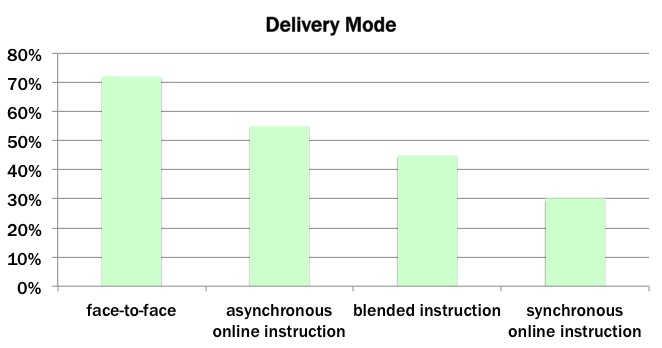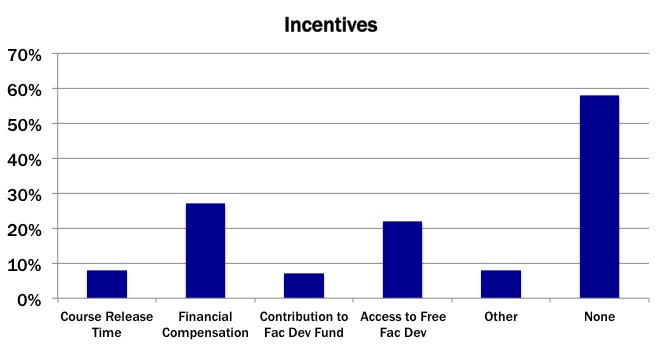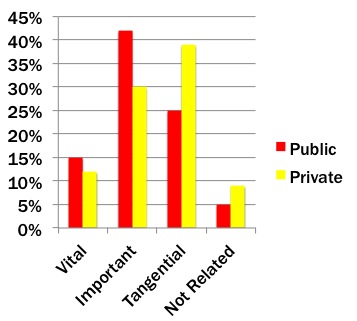Faculty Development for Blended Learning: A Survey of Practices
Published by: WCET | 12/5/2012
Tags: Blended/Hybrid Learning, Faculty, Professional Development, Teaching
Published by: WCET | 12/5/2012
Tags: Blended/Hybrid Learning, Faculty, Professional Development, Teaching
WCET is pleased to welcome Liz Ciabocchi and Amy Ginsberg of Long Island University as guest bloggers in sharing their research on faculty development. Thank you to WCET members who responded to their survey on training opportunities for blended learning faculty. Liz and Amy share highlights of their results in this posting.
Like so many of our colleagues in higher education, we are constantly researching best practices and evaluating models employed by others to improve our faculty development practices and meet our faculty’s needs in the most effective and cost-efficient way possible. Over the past several years, we have been compelled to expand faculty development opportunities in blended and online teaching and learning, in particular, as these instructional formats begin to take hold at our institution.
Long Island University is a private, comprehensive, multi-campus university in New York that offers an array of degree and certificate programs in the liberal arts and sciences, health professions, business, visual and performing arts, education and library/information sciences. With the exception of a well established, fully online master’s degree in Homeland Security Management and a handful of certificate programs, the vast majority of academic programs at LIU are currently offered in a traditional, face-to-face format. In the past several years, a small but growing portfolio of blended graduate and professional degree programs has been developed, and a sizeable number of faculty are now teaching (or soon will be) in a blended format.
Faculty development strategies for the ever-increasing number of faculty teaching blended or online at LIU have been expanded from exclusively face-to-face workshops to include internally- and externally-run online courses. An internally-developed certification program is also currently under discussion.
Literature Review and Survey on Blended Learning Faculty Development
Our personal involvement and research interest in this area of faculty development prompted us to explore in greater detail the current state of faculty training for blended course instruction in traditional higher education institutions.
A review of the literature in this area revealed that, despite the rapid proliferation of blended learning programs in U.S. higher education and the undeniable reality that faculty development is critical to this effort, the research to date about faculty development specifically for blended instruction within traditional higher education institutions like ours—where much of this growth is taking place—is scarce.
As a next step, we decided to undertake a pilot survey research project aimed at traditional, not-for-profit traditional higher education institutions and focused on 1) the design, structure, and implementation of faculty development programs for blended teaching and learning, 2) the perceptions of the most and least successful elements of the programs, and, 3) the philosophical underpinnings of program design. In light of the steady and growing trend toward an increase in online and blended learning at institutions of higher education, including LIU, the survey was designed to generate information to facilitate discussion among decision-makers at our institution and others regarding faculty development for blended course instruction.
The Survey Results
Types of Institutions Responding & Faculty Requirements
Our sample included 70 public and 39 private institutions. Overall, whereas only 25% of these institutions required faculty development for blended instruction, 51% recommended such faculty development. Interestingly, public institutions were found to be far more likely than private institutions to recommend (vs. require) faculty development for blended instruction. On the other hand, private institutions were more likely than public institutions to require faculty development when it was offered, but they were also more likely not to offer faculty development for blended instruction at all. Most institutions, both public and private, offered blended courses in primarily face-to-face programs. Public institutions were more likely than private institutions to offer online programs including blended courses.
Modes of Training Offered

Internal training courses and informal mentoring were the most common types of faculty development for blended instruction. Only 15% or so of the sample offered an internal certification program, and an even smaller number (about 10%) utilized external training courses. Surprisingly, face-to-face was the most common delivery mode for faculty development, followed by asynchronous online instruction, blended instruction, and synchronous online instruction.
Office Responsible for Faculty Development
We found that Academic Affairs was the office most often responsible for faculty development for blended instruction, followed by Information Technology or Distance Education. At some institutions, the academic department, division, school or college holds this responsibility. At even fewer institutions, faculty development is housed in an office of instructional technology, continuing education or the library.

Faculty Incentives
We were surprised to find that over half of the institutions in the sample did not provide any incentives for faculty to engage in development for blended instruction. When incentives were offered, financial compensation was most common. Institutional representatives attributed the success of their faculty development to the design of the program, the quality of instruction, the convenience of the delivery format, and faculty development/buy-in. When asked how faculty development for blended instruction could be improved, institutional representatives suggested providing incentives and requiring the training.
Strategic Importance

This study also tapped into another area of significant interest to us, which was the importance of faculty development in blended instruction to institutional strategic planning. The preliminary data suggest that faculty development is viewed as more important in strategic planning in public institutions vs. private institutions.
Conclusions and Recommendations
In sum, our findings are consistent with the literature in terms of the most common types of faculty development programs (i.e., internally offered programs, informal mentoring and formal mentoring), the variability of institutional practices and faculty development models for blended instruction, and the perception that the variety of training opportunities and delivery formats created convenience and flexibility that were critical to success of the effort.
Recommendations from this study provide significant food for thought:
We look forward to continued productive discussion in consideration of these and a host of other issues to advance initiatives to train faculty for blended and online instruction.
Note: The full research study will appear in a forthcoming book publication, Research Perspectives in Blended Learning, Routledge/Taylor and Francis Publishers (C. Dziuban, C. Graham & A. G. Picciano, editors) in late 2013. Additionally, we would like to thank WCET for their assistance with this project.

